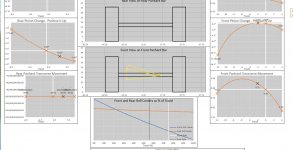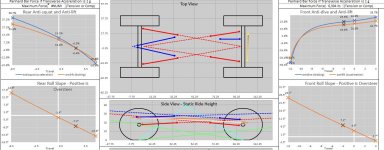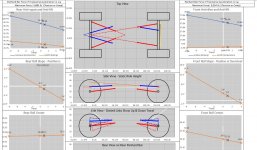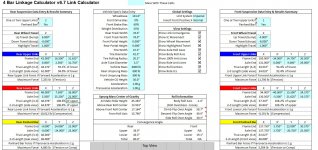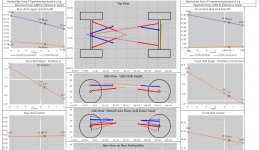My vehicle currently has a 3 link front and leaf springs in the rear (chevy 63’s). The numbers for the front suspension can be seen in attached images below, and these front values will be constant/constrained for the sake of this post (as i dont want to change this currently).
With the leaf springs, the rear roll center height was measured at about 32.5” (front is about 28.125”), and this would lead to an oversteer setup.
To that point, I have been driving the vehicle to and from the trail and the truck handles incredibly well at speeds in 2 wheel drive (no unwanted or unpredictable handling characteristics at highway speeds). However, I haven’t driven many linked rear suspension vehicles and if there is room for improvement, I’m all ears (I just don’t want to link the rear, and have something that handles horribly which is my biggest fear and unknown).
During my trip to the Rubicon this summer, I noticed the rear suspension wanting to wrap and hop while on the trail (very slow speeds and in low-low 4 wheel drive), so I figured I would begin my next phase in the build which would be to 4-link the rear suspension.
My overall goals with the truck still revolve around driving to the trail, wheel the trail and then drive home. To that point, my focus of this post will initially be around the trip to and from the trail in 2 wheel drive at highway speeds, and then evolve the conversation as to what impacts the desired outcome would have on the truck in a rock crawling scenario.
When manipulating the newest 4 link calculator my focus has been primarily on the values for the roll axes. Where I’m getting torn and looking to develop a better understanding is which is more desirable for rear 2 wheel drive power transmission at highway speeds; is it more desirable to focus on the vehicle body roll and keeping this value tight (roll axis slopes upward towards the front suspension) or would it be preferred to target a very negative rear roll axis height, but develops a loose body roll axis (slopes downward towards the front suspension)?
Option 1:
A rear roll center height of 28.125” and a rear roll slope of -0.3° (Body Roll Axis = 0.02° Roll Understeer – tight)
Rear Instant Center coordinates:
x = 121.54"
z = 34.18"
Option 2:
A rear roll center height of 31.36” and a rear roll slope of -3.1° (Body Roll Axis = -1.4° Roll Oversteer – loose)
Rear Instant Center coordinates:
x = 108.38"
z = 31.43"
For these two options, the anti-squat values in a 2wd scenario is 93% and 96% respectively.
